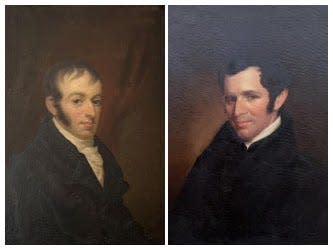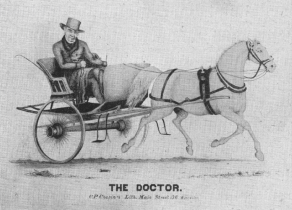Drs. John Green: Family's legacy in Worcester goes beyond medicine

Three physicians - all named John Green - from successive generations played a large role both in the development of Worcester as a town (and then a city) and in the advancement of medicine in Worcester.
It all began just west of Worcester in Leicester where in the early 18th century the Rev. Thomas Green established the First Baptist Church. In addition to being a preacher, Thomas Green had also been trained informally in medicine and surgery by two men who had been boarders.
As a result of this training and further study on his own, his practice thrived as did his church. He actually began teaching others the practice of medicine as there were no medical schools in Massachusetts before Harvard Medical School was established in 1782.
Over the course of his career, he was responsible for training over 100 doctors. One of his sons, John Green, was trained by him in medicine and moved to Worcester in 1757 at age 21 to practice.
His father had purchased several hundred acres for him to build a home on the outskirts of town in what is now Green Hill Park.
The first John Green also built an office on Main Street, just down from the courthouse, and began his practice. Worcester at that time had a population of less than 2,000. His office was in one of only seven houses located on Main Street, which ran from what is now Lincoln Square to the Town Square, where City Hall is now located.
John Green married twice and had 12 children. One of these 12 was John Green Jr. - trained in medicine by his father. Father and son practiced together until the father’s death in 1799 at 63.
John Green Jr. built a house next to the medical office on Main Street and lived there rather than at the family home on Green Hill. Described as tall and strong with an attractive personality, he was extremely busy in the practice of medicine and the teaching of students, especially after his father died. One history notes: “While daily could be seen Dr. Green and his half dozen students mounted on horseback and galloping through the streets as if someone were in peril…”
Founders of Worcester Medical Society
Both father and son felt that doctors needed to have a professional organization. They were founding members, in 1794, of the Worcester Medical Society.
John Jr. was the first treasurer of the society. The purpose of the organization was to certify physicians as competent to practice as well as to provide a forum for discussing cases and educating fellow doctors regarding advances in medicine.
John Jr. was the father of 11 children and died in 1808 at only 45. One of his children was John Green III, who followed in the family tradition and entered the practice of medicine in Worcester.
John Green III was the first in the Green family to attend college. He graduated from Brown University in 1804 and assumed his father’s practice in 1807. About 20 years later, in 1826, he was granted an honorary degree in medicine from Harvard University. As an interesting footnote, Harvard Street, running parallel to Main Street, was named by Green to commemorate this honor.
John Green III was described as being slight, stooping and having a quiet, confident manner.
His reputation in the practice of medicine was unparalleled. He had received a thorough literary and professional training, but his skill in the "healing art" was to a remarkable degree the result of his observation and experience. He seemed to be able to discern disease with almost intuitive perception.
He inherited his father’s one-horse shay and was seen, like his father, charging through the streets of Worcester. A lithograph of him riding was in general publication and was hung in many homes. He was popular, prosperous and civic-minded, but not wholly selfless. It was noted that he and his associate would refuse to consult new physicians who tried to locate here, effectively freezing them out of Worcester.
The professional organization his father and grandfather had helped found became the Worcester District Medical Society in 1804, now a district of the Massachusetts Medical Society. John Green III served as president of this society for eight years, from 1830 to 1837. He was a strong advocate of the society’s library, lobbying for increasing the number of books. He designed the first official logo of the Worcester District Medical Society with emblematic skull and crossbones to emphasize that physicians must be careful not to do harm with their medicines.
Dr. Green practiced medicine in the first half of the 19th century, a time when more changes in medicine were taking place than had occurred in several previous centuries. His practice spanned a time when vaccination for smallpox was popularized, germ theory was developed and hygienic practices and anesthesia were put into use. These changes spurred his interest in a medical library. The need for up-to-date textbooks was never greater.
Founding of Worcester Free Library
Dr. Green was a bibliophile who collected thousands of books of all categories, not just medical. In 1859 he was instrumental in establishing the Worcester Free Library - bringing together two private subscription libraries and donating 5,000 books, valued at $10,000 - as part of his interest in providing for a library open to the general public. He also specified that space would be provided in that library to the Worcester District Medical Society for storage of its books so long as they would also be accessible to the public.
With his leadership a new public library was built on Elm Street, opening in 1861. Upon his death he left an additional 7,000 books as well as $30,000 to establish the Green Library fund.
The connection between the Worcester District Medical Society and the Worcester Public Library was maintained until the society moved out of the public library building in 1933 due to lack of space.
In addition to his leadership in medicine and his work on the establishment of the public library, John Green III served as the first president of the Worcester Horticultural Society (now New England Botanic Garden at Tower Hill). His portrait hangs today in the main building at Tower Hill.
Dr. Green served in various leadership positions with the medical society and the horticultural society. Over the course of his career, he was the recipient of numerous honors. John Street in Worcester was named for him in 1846.
John Green III retired from medicine in 1855 and died in 1865. He and his wife had no children, but his legacy lives on through his good deeds.
For more on the history of medicine in Worcester go to www.wdms.com. Dr. Robert Sorrenti contributed to this column.

This article originally appeared on Telegram & Gazette: Drs. John Green: Family's legacy in Worcester goes beyond medicine
